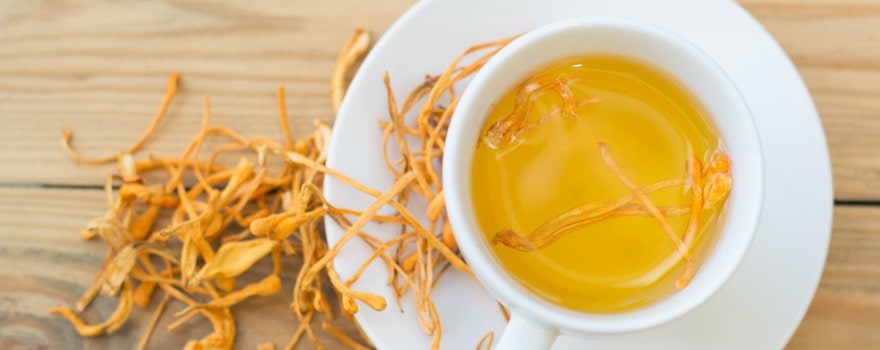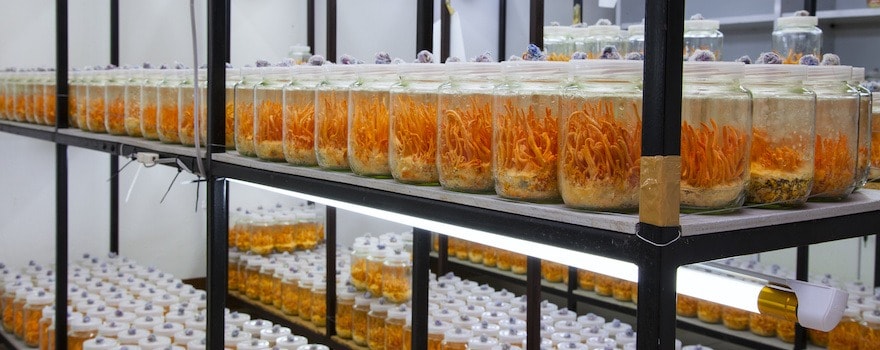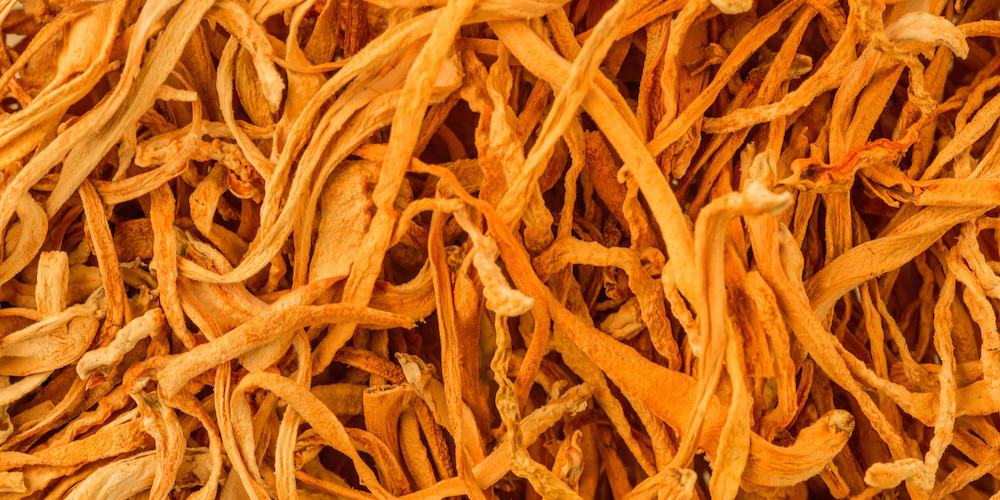CORDYCEPS BENEFITS
✓ Restores energy and vitality
✓ Strengthens the immune system
✓ Improves libido and sexual performance
✓ Supports nervous system balance
✓ Improves kidney function
What is cordyceps?
Cordyceps (Ophiocordyceps sinensis or formerly Cordyceps sinensis) is a fungus that grows in the mountainous regions of Asia, above 4,000 m altitude. It is generally found in the countries crossed by the Himalayas (Tibet, Nepal, Bhutan…) and as far as northeastern India, where it can withstand extreme climatic conditions.
From a botanical point of view, cordyceps is particularly remarkable. It belongs to the large family Ophiocordycipitaceae, which includes only what are called parasitic fungi.
Indeed, it parasitizes the larvae of caterpillars of the genus Thitarodes that spend the winter underground. This mode of development earned it the nickname ” caterpillar fungus ” and its Chinese name ” Dong Chong Xia Cao “, which means ” winter worm .”
From autumn, cordyceps develops inside the larva’s body. It gradually extends its mycelium until it kills and mummifies the insect. When temperatures warm in spring, it passes through the larva’s head to emerge at the surface.

The earliest recorded use of cordyceps as a medicinal remedy dates back to the 18th century. The Chinese and the Tibetans then consumed it to fight aging, reduce fatigue, tone the Qi (vital energy), and strengthen the body and mind… Legend has it that its virtues were discovered by nomadic Tibetans. They noticed that their herds were more vigorous after consuming wild cordyceps.
It was finally in the 1990s that it experienced an unprecedented boom. During the World Athletics Championships, two Chinese athletes broke three world records. Initially suspected of doping, they explained that they regularly consumed cordyceps decoctions.
Researchers therefore quickly became interested in this fungus for its ability to improve athletic performance in athletes. Studies have highlighted the compounds and certain properties of cordyceps.
Today, it is mainly consumed as a dietary supplement, in tablets or capsules, to regain tone and energy, improve libido and sexual performance.
Nutritional composition
- Nucléosides : adénosine, cordycepine
- Lipides
- Protéines
- 18 acides aminés (dont les 8 essentiels)
- Vitamines : E, K, B1, B2, B12
- Minéraux et oligo-éléments : cuivre, fer, sélénium, manganèse, zinc, calcium, magnésium
- Polysaccharides
- Stérols végétaux : ergostérol

The benefits of cordyceps
⚡️ Restores energy and vitality
Cordyceps has exceptional tonic, revitalizing, and energizing properties. It is an excellent natural remedy for regaining energy and vitality. This effect is due to its richness in vitamins, amino acids, minerals, and trace elements. In traditional Chinese medicine, it is a tonic for the Qi, the body’s energy.
The mushroom proves particularly effective in reducing fatigue and improving physical performance. In addition to providing energy, it allows better use of oxygen in the blood and cells. Its effects are mainly felt in terms of muscle strength and endurance.
In this study from the University of Pavia, conducted on amateur cyclists, researchers demonstrated the effectiveness of cordyceps. It can increase endurance time and protect athletes from symptoms of overtraining.
🛡 Strengthens the immune system
Cordyceps also has an immunostimulatory effect by acting directly on the cells of the immune system. The cordycepin it contains notably supports the production of NK lymphocytes, the natural killer cells responsible for the body’s immune defense.
The cordycepin also acts on the activity of superoxide dismutase and glutathione peroxidase, enzymes essential to the mechanism of trapping and eliminating free radicals.
Consuming it therefore helps limit oxidative damage and prevent many diseases. Cordyceps could potentially be a shield against cancer. Clinical studies are currently underway.
This publication explains the positive effects of cordyceps on the immune system.
🔥 Improves libido and sexual performance
The effect of cordyceps on sexual activity has been demonstrated repeatedly. By increasing energy and improving oxygen utilization, the mushroom enhances sexual function.
Nicknamed the “viagra of the Himalayas”, cordyceps also has aphrodisiac properties. In traditional Chinese medicine, it is recommended to treat impotence, stimulate erection and increase sperm production. These properties are also found in maca.
This effect on sexual and reproductive function is due to its richness in vitamins, zinc and amino acids. This mushroom significantly increases the release of testosterone via adenosine monophosphate. It also causes vasodilation and increases blood flow during erection.
This study from Mahidol University in Thailand shows that taking cordyceps led to a significant improvement in libido and desire in both men and women.
🙏 Supports nervous system balance
Although its action on the nervous system is less well known, cordyceps is a valuable ally in the fight against stress, anxiety, depression and burnout — and in this respect is reminiscent of rhodiola. In traditional Chinese medicine, it is recommended to speed recovery in cases of mental exhaustion.
Like ginseng, maca, and astragalus, it has adaptogenic properties. It thus increases the body’s resistance to stressful situations.
This study from Dongduk Women’s University in Seoul, conducted on rats and mice, shows that cordyceps effectively reduced fatigue and stress.
♻️ Improves kidney function
Cordyceps is a major protector of the kidneys and of kidney function. In addition to protecting them against toxic substances, it prevents certain kidney diseases such as chronic nephritis, chronic pyelonephritis, or kidney failure.
It stimulates kidney function, especially in patients with chronic kidney disease (CKD). Thanks to its anti-inflammatory action, it also reduces kidney inflammation that prevents them from functioning normally.
This study from the University of Alabama in the United States highlights the effects of cordyceps and, in particular, its potential as an adjunctive treatment for kidney failure.

How to consume cordyceps?
Prefer organic cordyceps
As with other mushrooms, such as the shiitake, we recommend choosing certified organic cordyceps. Mushrooms are real sponges : they can absorb pollutants present in the soil (pesticide residues, heavy metals…).
That is why it’s preferable to choose cordyceps that have been grown organically and come from a controlled supply chain. You should also be able to trace its origin. The United States and Tibet are currently the main producers. Organic cordyceps can be easily found in specialty health food stores or online.
Cordyceps tablets
Cordyceps tablets or capsules contain dried cordyceps ground into powder. This is the most common and most accessible form.
Be careful, however, to choose a quality product : it should be sufficiently high in adenosine and cordycepic acid (D-mannitol), its main bioactive compounds.
Cordyceps powder
Cordyceps powder is most often found online or in Asian stores. It is used mixed with water, tea, fruit juice, smoothies, or sprinkled over soups, salads…
However, it does have a fairly strong mushroom flavor that won’t necessarily appeal to everyone.
Make sure to check that the powder consists only of cordyceps and contains no additives.
Fresh or dried cordyceps

In Asian stores, you can buy fresh or dried cordyceps, both of which offer interesting nutritional values. In China, they are often consumed as herbal tea, as a decoction, or added directly to dishes. They are commonly used to prepare soups or broths.
If you buy dried cordyceps, consider rehydrating them in water for 1 hour. Fresh cordyceps, on the other hand, should not be washed to prevent them from soaking up water and turning into a sponge. They are quickly cleaned using a vegetable brush.
Cordyceps and ginseng
In the « Imperial Trio » (an ancestral combination of Chinese plants reserved for emperors and nobility), cordyceps is notably paired with ginseng and the ganoderma mushroom (or reishi). This superfood is also an excellent anti-fatigue remedy that improves vitality and the body’s resilience. The cordyceps/ginseng combination is ideal in cases of extreme fatigue.
Ginseng is also considered an aphrodisiac that works in synergy with cordyceps to increase sexual energy and combat impotence.
Cordyceps dosage
⚖️Generally speaking, the recommended dosage is 3 to 6 g of cordyceps per day to benefit from its effects. Initial results are usually felt after a few days.
⏳The dosage may be higher in cases of intense athletic practice or to deeply stimulate the immune system. In that case, it should be taken as a 3-month course, with a one-week break every 4 weeks.
💊In tablet form : up to 3 per day for 500 mg tablets or capsules
🥄In powder form : 1/2 teaspoon
Contraindications and side effects
Cordyceps is generally well tolerated by the body. However, its consumption is not recommended for the following people :
- Par mesure de précaution, les enfants de moins de 18 ans, les femmes enceintes ou qui allaitent ne doivent pas en consommer.
- Sa consommation est contre-indiquée aux personnes hémophiles ou sous traitement anti-coagulant.
Reported side effects are few and most often mild. Thus, its consumption may cause:
- Éruptions cutanées.
- Nausées.
- Maux d’estomac et troubles digestifs.
- Diarrhées.
- Sensation de bouche sèche.
If symptoms persist, it is advisable to stop using it and consult a doctor.
History, cultivation, and market of cordyceps
A rare and precious mushroom
For centuries, cordyceps has been an integral part of traditional Chinese and Tibetan medicine. Originally, its consumption was reserved for a privileged few: only the Dalai Lama, the Emperor of China and his court could enjoy the benefits of wild cordyceps.
It was a particularly rare mushroom, with very unusual development and growth. And therefore a very expensive product that only a few people could afford.
Even today, cordyceps is still sold for a fortune and is much more expensive than Panax ginseng. Which is why the wild variety is almost impossible to find in France. It’s probably for that reason that it’s nicknamed “brown gold”…
Unfortunately, this unprecedented craze has led to intensive harvesting. The wild mushroom is becoming increasingly rare. Tibetan farmers and herders, for whom its sale represents an important share of income, must now climb to over 4,500 meters in altitude.
They also have to face the arrival of numerous foragers, coming from China or abroad, searching for the precious caterpillar fungus. Its intensive harvesting therefore causes both ecological and social problems.
A culture that has adapted

To meet a growing global demand, it has been cultivated in artificial environments. These reproduce as closely as possible the natural environment and growth conditions of wild cordyceps. Thus, it is grown on rice straws in a low-temperature environment with an oxygen supply similar to high-altitude regions.
This cultivation makes it possible to obtain concentrated cordyceps rich in active compounds and offering the same properties as wild ones. Finally, it has also helped democratize its use worldwide.
Detailed nutritional values
These data were compiled and verified for Darwin Nutrition by Laure Fourchaud, Doctor of nutritional physiology.
| Cordyceps powder | /100g | %AR* | /5g (1cc) | %AR |
| Energy (kcal) | 401 | 20 | 20,05 | 1 |
| Fiber (g) | ||||
| Water (g) | ||||
| Macronutrients | ||||
| Protein (g) | 25 | 50 | 1,25 | 2,5 |
| Carbohydrates (g) | 29 | 11,15 | 1,45 | 0,56 |
| Of which sugars (g) | ||||
| Fat (g) | 8,4 | 12 | 0,42 | 0,6 |
| Minerals | ||||
| Calcium (mg) | 146 | 18,25 | 7,3 | 0,91 |
| Iron (mg) | 20,6 | 147,14 | 1,03 | 7,36 |
| Copper (mg) | 0,3 | 30 | 0,015 | 1,5 |
| Magnesium (mg) | 258 | 68,8 | 12,9 | 3,44 |
| Manganese (mg) | 1,2 | 60 | 0,06 | 3 |
| Phosphorus (mg) | — | — | — | — |
| Potassium (mg) | — | — | — | — |
| Sodium (mg) | — | — | — | — |
| Salt (g) | — | — | — | — |
| Zinc (mg) | 3,4 | 34 | 0,17 | 1,7 |
| Vitamins | ||||
| Vitamin A (mg) | 0,1 | 0,01 | 0,005 | 0 |
| Vitamin C (mg) | — | — | — | — |
| Vitamin D (µg) | 0,2 | 4 | 0,01 | 0,2 |
| Vitamin E (mg) | — | — | — | — |
| Vitamin B1 (mg) | yes | |||
| Vitamin B2 (mg) | yes | |||
| Vitamin B3 (mg) | — | — | — | — |
| Vitamin B5 (mg) | — | — | — | — |
| Vitamin B6 (mg) | — | — | — | — |
| Vitamin B9 or folate (µg) | — | — | — | — |
| Vitamin B12 (µg) | yes | |||
| Vitamin K (µg) | yes |
*%AR : % Reference intake for an adult
Antioxidants: carotenoids, phycocyanins, superoxide dismutase
Report prepared by Julia Perez and Charlotte Jean
Sources and scientific studies
Paola Rossi, Daniela Buonocore, Elisa Altobelli, Federico Brandalise, Valentina Cesaroni, Davide Iozzi, Elena Savino, and Fulvio Marzatico, 2014. Improving Training Condition Assessment in Endurance Cyclists: Effects of Ganoderma lucidum and Ophiocordyceps sinensis Dietary Supplementation.
Bao-qin Lin, Shao-ping Li, 2011. Cordyceps as an Herbal Drug.
Kanitta Jiraungkoorskul, Wannee Jiraungkoorskul, 2016. Review of Naturopathy of Medical Mushroom, Ophiocordyceps Sinensis, in Sexual Dysfunction.
Koh JH, Kim KM, Kim JM, Song JC, Suh HJ, 2003. Antifatigue and antistress effect of the hot-water fraction from mycelia of Cordyceps sinensis.
Jeevan K. Prasain, 2013. Pharmacological Effects of Cordyceps and Its Bioactive Compounds.
Tuli HS, Sandhu SS, Sharma AK. Pharmacological and therapeutic potential of Cordyceps with special reference to Cordycepin. 3 Biotech. 2014;4(1):1‐12. doi:10.1007/s13205-013-0121-9
Xiao, Jian-Hui & Xiao, Dai-Min & Sun, Zhong-Hua & Xiong, Qing & Liang, Zong-Qi & Zhong, Jian-Jiang. (2009). Chemical compositions and antimicrobial property of three edible and medicinal Cordyceps species. Journal of Food, Agriculture and Environment. 7.
Chan, Jannie & Barseghyan, Gayane & Asatiani, Mikheil & Wasser, Solomon. (2015). Chemical Composition and Medicinal Value of Fruiting Bodies and Submerged Cultured Mycelia of Caterpillar Medicinal Fungus Cordyceps militaris CBS-132098 (Ascomycetes). International Journal of Medicinal Mushrooms. 17. 649-659. 10.1615/IntJMedMushrooms.v17.i7.50.



